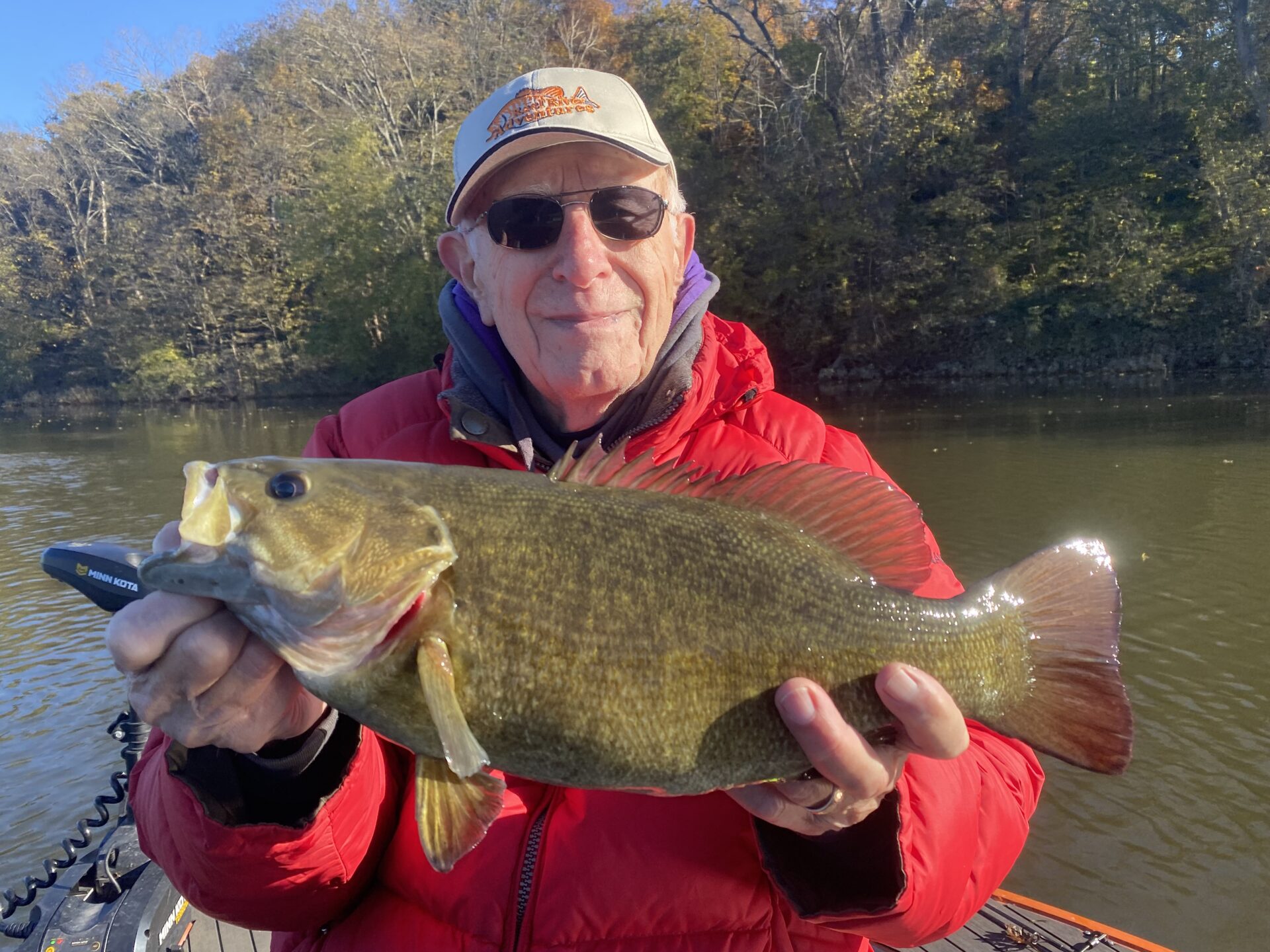Coming from a career in the field of Research & Development, keeping lab notes, logging records and analyzing findings became a daily habit. When it came to fishing, following suit just felt natural.
And as a result, there are decades of paper and digital notes logging thousands of days on the water. Believe me, the logs kept were simple and easy. Essentially, the log was a subset of items any angler may ask before setting out. Water and air temperatures, river levels and conditions, weather patterns and of course how successful the day was and what lures and colors produced.
Early on, these logs were a way to tally the number of bass caught annually. But as time went on, they provided useful keys to success on the water. They were counted on during seasonal changes and even drastic changes in water levels. The logs provided a much-needed boost or excuse to go out and just give it a try when the weather, wind and water conditions were far less than ideal.
Doing research for the logbook kept me off the couch more than a time or two. During times when I was off the water for a period of time, reviewing dates and similar conditions from previous years would add confidence and usually reduce the time searching for a bite once on the water.
Today, and for the last dozen or so years, time off the water is rare. But those notes are still visited now and again. Having decades of information has pointed to several annual trends in weather and nature that seem very consistent year over year. One of these trends is about to happen as I write this, and it will be interesting to see if it will play out as it has in 35 of the last 38 years I have been tracking it.
The event generally occurs somewhere between the last 10 days of October and the first week of November. During this window of time there is a change in water level as a result of a storm or storms that take the river to autumn levels. It does not matter how low the rivers are at the start of autumn, this rain event is large enough to add significant water into the river basin. Once the levels rise, historically the level rarely drops much at all through the end of the year. Best of all, the event kicks off the ‘Fall Feeding Frenzy’.
The river charts I created this morning as I write this show a solid blue line; the Susquehanna and Delaware rivers as they are today. Yellow markers in the graph represent the median level, composed of 100+ years of data. And while there is no way to truly know if or when this event will occur, I can see by the historical records, the event is in the works.
During this event, there are a number of lures to select, for this time of year, moderately rising water with a bit of stain creates the perfect conditions for a number of finesse and power baits alike. Lipless cranks are my first choice for these conditions. With water temperatures in the mid to upper 50’s, bass are more than willing to chase more aggressive presentations and more often than not, the power anglers have the advantage here. Nothing screams the arrival of fall better than the sound of those rattles during retrieval. On the rivers I fish, smallmouth can not resist them.
Whether you are a fan of the original Bill Lewis Rat-L-Trap, or prefer lipless cranks from Rapala, Cotton Cordel, Strike King, 6th Sense, Booyah, Googan Squad…the list goes on and on. To help narrow it down some, select a size and color that best suits the ever changing conditions. A general safe rule is the more stain the water has, the larger and gaudy, the better. Firetiger, bright orange and gold just to name a few choices. In lighter stain, more natural looking minnow and craw patterns work great. Many days, clients just throw gold or chrome because that is what they are comfortable with.
My knee jerk response to clients tossing them for the first time is “just chuck and reel”. As with many lures, the bass will dictate the cadence they want and anglers will soon feel and hear the cadence that works. As anglers get more in tune with them, I suggest tossing them in and as soon as they touch bottom, rip the rod tip and start reeling. This sudden explosion off the river bottom can create strikes, even though the risk of snagging is greater than just a steady cast and reel. Search out ambush areas and make these areas your primary casting targets. Submerged wood, rock or any structure that is diverting current. Islands, shore points and micro eddies will produce, just cover water and vary the speed until you find them.
Lipless cranks come through vegetation quite a bit better than lipped cranks. If anglers are fighting the last vegetation of the year, I recommend beefing up the line and the action a little. Rod choice for me is generally a medium powered rod with moderate to slow action. If vegetation is a factor, going to heavier line and a medium heavy rod with the same action is going to be helpful. In “light” vegetation, a quick snap with the rod once or twice will break it free and lipless cranks tend to work even when there is a strand or two of grass on them. As long as you feel the vibration, they will work regardless of the grassy trailer it picked up.
oming from a career in the field of Research & Development, keeping lab notes, logging records and analyzing findings became a daily habit. When it came to fishing, following suit just felt natural.
And as a result, there are decades of paper and digital notes logging thousands of days on the water. Believe me, the logs kept were simple and easy. Essentially, the log was a subset of items any angler may ask before setting out. Water and air temperatures, river levels and conditions, weather patterns and of course how successful the day was and what lures and colors produced.
Early on, these logs were a way to tally the number of bass caught annually. But as time went on, they provided useful keys to success on the water. They were counted on during seasonal changes and even drastic changes in water levels. The logs provided a much-needed boost or excuse to go out and just give it a try when the weather, wind and water conditions were far less than ideal.
Doing research for the logbook kept me off the couch more than a time or two. During times when I was off the water for a period of time, reviewing dates and similar conditions from previous years would add confidence and usually reduce the time searching for a bite once on the water.
Today, and for the last dozen or so years, time off the water is rare. But those notes are still visited now and again. Having decades of information has pointed to several annual trends in weather and nature that seem very consistent year over year. One of these trends is about to happen as I write this, and it will be interesting to see if it will play out as it has in 35 of the last 38 years I have been tracking it.
The event generally occurs somewhere between the last 10 days of October and the first week of November. During this window of time there is a change in water level as a result of a storm or storms that take the river to autumn levels. It does not matter how low the rivers are at the start of autumn, this rain event is large enough to add significant water into the river basin. Once the levels rise, historically the level rarely drops much at all through the end of the year. Best of all, the event kicks off the ‘Fall Feeding Frenzy’.
The river charts I created this morning as I write this show a solid blue line; the Susquehanna and Delaware rivers as they are today. Yellow markers in the graph represent the median level, composed of 100+ years of data. And while there is no way to truly know if or when this event will occur, I can see by the historical records, the event is in the works.
During this event, there are a number of lures to select, for this time of year, moderately rising water with a bit of stain creates the perfect conditions for a number of finesse and power baits alike. Lipless cranks are my first choice for these conditions. With water temperatures in the mid to upper 50’s, bass are more than willing to chase more aggressive presentations and more often than not, the power anglers have the advantage here. Nothing screams the arrival of fall better than the sound of those rattles during retrieval. On the rivers I fish, smallmouth can not resist them.
Whether you are a fan of the original Bill Lewis Rat-L-Trap, or prefer lipless cranks from Rapala, Cotton Cordel, Strike King, 6th Sense, Booyah, Googan Squad…the list goes on and on. To help narrow it down some, select a size and color that best suits the ever changing conditions. A general safe rule is the more stain the water has, the larger and gaudy, the better. Firetiger, bright orange and gold just to name a few choices. In lighter stain, more natural looking minnow and craw patterns work great. Many days, clients just throw gold or chrome because that is what they are comfortable with.
My knee jerk response to clients tossing them for the first time is “just chuck and reel”. As with many lures, the bass will dictate the cadence they want and anglers will soon feel and hear the cadence that works. As anglers get more in tune with them, I suggest tossing them in and as soon as they touch bottom, rip the rod tip and start reeling. This sudden explosion off the river bottom can create strikes, even though the risk of snagging is greater than just a steady cast and reel. Search out ambush areas and make these areas your primary casting targets. Submerged wood, rock or any structure that is diverting current. Islands, shore points and micro eddies will produce, just cover water and vary the speed until you find them.
Lipless cranks come through vegetation quite a bit better than lipped cranks. If anglers are fighting the last vegetation of the year, I recommend beefing up the line and the action a little. Rod choice for me is generally a medium powered rod with moderate to slow action. If vegetation is a factor, going to heavier line and a medium heavy rod with the same action is going to be helpful. In “light” vegetation, a quick snap with the rod once or twice will break it free and lipless cranks tend to work even when there is a strand or two of grass on them. As long as you feel the vibration, they will work regardless of the grassy trailer it picked up.
Author Chris Gorsuch is a licensed charter guide in the state of Pennsylvania. He started the Reel River Adventures guide service in ‘07 and spends 225-250 days on the water annually. His home base is on the Susquehanna River. Follow his daily fishing reports on Facebook ‘Reel River Adventures-RRA’ & Instagram @Chris_Gorsuch
So break out the old box of lipless cranks or get some new ones and start experimenting with color, size and cadence. I genuinely want to hear readers experiences in these conditions and what their own ‘field research’ has shown.



